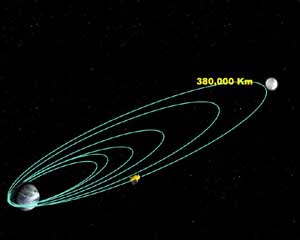Chandrayaan enters lunar transfer orbit
05 Nov 2008
Chennai: India's lunar orbiter, Chandrayaan-1, became the first indigenously-built spacecraft to exit the earth's gravity. It entered the lunar transfer orbit after its on-board engine fired for two and a half minutes on Tuesday morning.
An ISRO communique said that the fifth and final orbit raising manoeuvre of Chandrayaan-1 was successfully carried out at 04:56 am IST, when the spacecraft's 440 Newton liquid engine was fired for about two and a half minutes. With this, it said, Chandrayaan-1 entered the Lunar Transfer Trajectory with an apogee (farthest point to Earth) of about 380,000 km.
 The spacecraft is now in lunar transfer orbit and will be inserted into a polar lunar orbit on 15 November 2008. The lunar probe has traversed a distance of 380,000 km from the earth on its way to the moon, which is at a distance of 384,000 km from the earth.
The spacecraft is now in lunar transfer orbit and will be inserted into a polar lunar orbit on 15 November 2008. The lunar probe has traversed a distance of 380,000 km from the earth on its way to the moon, which is at a distance of 384,000 km from the earth.
According to M Annadurai, project director, Chandrayaan-1, ''The spacecraft is in lunar transfer orbit. Everything is normal. We will do the lunar insertion manoeuvre of the spacecraft on 8 November. We are working for the spacecraft to reach its final lunar orbit on 15 November.''
Annadurai also clarified that ''everything is proceeding as per plan. We will continue to monitor and track the spacecraft.''
En route to the moon, Chandrayaan-1 has already switched on one of its payloads, the Terrain Mapping Camera (TMC), which has begun beaming down pictures of the earth.. The Indian Space Research Organisation (ISRO) is controlling the traveling spacecraft through the Spacecraft Control Centre, located at the ISRO Telemetry, Tracking and Command Network (ISTRAC), Bangalore.
The ISTRAC facility controls two huge 32 metre and 18 metre diametre antennas, located at Byalalu village, 40 km away from Bangalore. These antennas will send and receive all signals from the spacecraft, and subsequent deep space missions.
SK Shivakumar, ISTRAC director, said: ''Chandrayaan-1 is on the way to the moon now. Its apogee will be 380,000 km. It is the first Indian-built spacecraft to leave the earth's gravity. It has enough escape-velocity to leave the earth's gravity.''
Shivakumar also said that the spacecraft was in good shape and that the twin antennas at Bylalu were ''very much tracking'' it.
On 15 November the probe will be lowered into its final orbit when begins to circle the moon over its poles at an altitude of 100 km.













.jpg)






.jpg)









